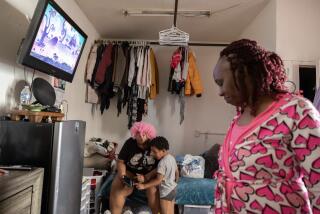A painful renovation for homeowner and Glendale
Stacks of legal documents cover the kitchen table, and architectural plans poke from pantry shelves at Judy Shea’s home.
Her kitchen has become central command in a long-running battle with Glendale City Hall. It’s an extremely expensive fight that she hopes will end with her regaining control of her home and a nightmare home improvement project.
“They’re drowning me,” Shea said of the city as she riffled through stacks of paperwork and bills.
Officials say Shea is anything but a victim: The city says she and her family brought trouble upon themselves when they nearly quadrupled the size of their home without seeking city approval or construction permits.
After years of failing to persuade the owner to bring the home into compliance with building and safety codes, officials got a judge to appoint a receiver, at Shea’s expense.
“This is the only time in Glendale’s history that the city’s done this type of receivership, and it might be the last time,” Deputy City Atty. Yvette Neukian said. “We needed to take extreme measures.”
In addition to failing to obtain permits, Shea endangered people living in her home at 4104 Lowell Ave., the city argued in Los Angeles County Superior Court filings.
More and more cities have turned to receivers to combat hoarding and other health and safety issues, said Andrew Adams, the receiver in Shea’s case. Traditionally, receivers are known for their work on bankruptcy cases, but courts appoint them in other matters and rely on them to manage properties that are under litigation or to execute a judge’s orders.
“It’s meant for these weird, awkward, tricky situations,” said Adams, of Los Angeles-based California Receivership Group. “Sometimes these things get contentious.”
In 2001, Shea’s son, Jesse Yzaguirre, began renovating the house and nearly quadrupled its size to 4,919 square feet. The work, however, never received city design approval or construction permits. In 2005, city officials filed a misdemeanor criminal complaint against Yzaguirre, who was put on probation for three years.
Shea admits that her son was wrong to build without permits but said he was unaware they were required. She said she has been unable to obtain permits, because she lacks plan approval from the city.
City officials say the plans were incomplete and couldn’t be approved.
In 2009, about six months before his probation was to expire, Yzaguirre applied for design approval, which was denied by Glendale’s Design Review Board in January 2010.
City officials inspected the house several months later and determined that a second story and detached garage had been built without permits. They also noted junk in the yard and other issues, according to city records.
“All of the unpermitted alterations, additions and property maintenance issues in my opinion create an unsafe dwelling,” Rene Sada, a code enforcement officer, wrote in a June 16, 2010, inspection report.
About a week later, Shea was given 72 hours to fix the violations or the city would ask for a receiver to take over the property.
Shea’s attorney, Dennis Fuire, argued in court documents that Shea could not fix the problems within 72 hours because most of the changes would have to be approved by the Design Review Board.
Six months later, Los Angeles County Superior Court Judge Donna Fields Goldstein appointed a receiver to get the house into compliance with health and safety regulations.
“When a receiver is appointed, the property owner loses control over everything,” Neukian said.
For Shea, the process has been expensive. The receiver charges $150 an hour, while Shea also pays $500 a month for administration expenses and up to $150 an hour to a consultant hired by the receiver to shepherd plans through the city’s planning department. Shea estimates she’ll rack up about $35,000 in fees, then face thousands of dollars in city and legal fees.
The Design Review Board has approved plans for the outside of Shea’s house, but city planners have yet to sign off on permits for the building’s interior. Part of the holdup is due to Shea changing the design plans to cut costs, Neukian said.
Getting the house up to code could cost about $200,000, according to initial construction bids. But since the receiver has placed a priority lien on the house, Shea can’t secure a bank loan. Instead, the receiver plans to get money from private lenders, who could charge up to 15% interest.
“If this continues, we’ll be driven into foreclosure,” Shea said.
More to Read
Sign up for Essential California
The most important California stories and recommendations in your inbox every morning.
You may occasionally receive promotional content from the Los Angeles Times.










